How to Choose Between Thermal Imagers and Night Vision Devices During Use
Night vision devices actively receive and image, just like our eyes can see reflected light. The working principle of daylight cameras, night vision devices, and human eyes is the same: visible light energy hits an object and reflects it, and then the detector receives and converts it into an image. Whether it's the eyes or night vision devices, these detectors must receive enough light, otherwise they won't be able to image.
The green images we see in movies or television are from night vision goggles (NVGs) or other devices that use the same core technology. NVGs receive a small amount of visible light, amplify it, and project it onto a display.
Cameras made with NVGs technology have the same limitations as the naked eye: they cannot see clearly without sufficient visible light. NVGs and other low light cameras cannot work in environments with too strong or too weak lighting. Because the light is too strong to work effectively, but the light is insufficient and cannot be seen with the naked eye.
Thermal imaging cameras do not require a light source
A thermal imager can be completely without a light source. Although we call them 'cameras', they are actually sensors. FLIRs capture images using thermal energy rather than visible light, as both heat (also known as infrared or thermal energy) and light are part of the electromagnetic spectrum.
A thermal imager can not only detect heat, but also detect tiny differences in heat, even as small as 0.01 degrees Celsius, and display them as gray or different colors. This may be a difficult idea to understand, and many people just don't understand the concept, so we will take some time to explain it.
Everything we encounter in our daily lives releases heat, even ice. The hotter an object is, the more heat energy is released, and this emitted heat energy is called a "thermal signal". When two adjacent objects have subtle different thermal signals, even in completely dark environments, they will clearly appear on the FLIR thermal imager.
Because different materials absorb and radiate thermal energy at different rates, this is the true apple and plastic apple model. They are not different under night vision cameras, but there is a significant difference under thermal imaging cameras, and the Fresnel thermal imaging camera can convert the detected temperature differences into image details. Although all of these may seem quite complex, the reality is that the Fresnel thermal imager is very easy to use.






